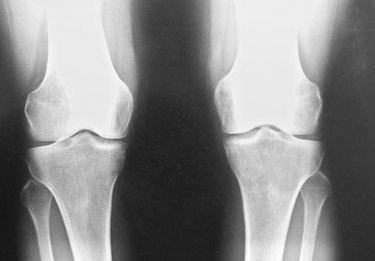
The space between the femur, or thighbone, and the tibia, or shinbone, on X-ray views represents the overall thickness of the joint cartilage surfaces of each opposing bone as they articulate, or come into contact with one another. As this cartilage wears down over time, and as part of the degenerative process associated with arthritis, this so-called space begins to narrow—not unlike tread on a tire. Degenerative joint disease in the knee can be treated in a variety of ways, each with their own specific goals.
Oral Pain Medication
Video of the Day
Oral pain medication, whether over-the-counter or prescription, is used predominately to treat pain associated with joint degeneration. Medications that are typically utilized in this treatment regimen include acetaminophen, aspirin, codeine, oxycodone and hydrocodone. The mechanism of action of oral pain medications, such as analgesics, focuses on dulling the brain's perception of pain, rather than attacking the mechanisms involved in the pain cycle.
Video of the Day
NSAIDs
Treatment of pain and inflammation by the oral route is elevated a notch by the use of substances called nonsteroidal anti-inflammatory agents, or NSAIDs. These drugs treat pain in an entirely different manner than do the traditional oral analgesics.
The mechanism of action of NSAIDs, as described by the American Academy of Orthopaedic Surgeons, focuses upon the prevention of an enzyme called cyclooxygenase from doing its job. Cyclooxygenase, commonly known as COX, comes in two distinct forms, one being beneficial to the body and the other a byproduct of joint and tissue injury and inflammation.
Steroid Injections
When conditions involving joint surface narrowing, such as degenerative arthritis, require a more localized approach to treating symptoms, intra-articular, or "into the joint," steroid injections can be very beneficial.
Cortisone is a potent anti-inflammatory agent, similar to the cortisone produced naturally in the body by the adrenal glands. Because medications placed into a joint are absorbed more slowly than those in an intramuscular injection, for example, and the potential for a systemic reaction to the drug is decreased, injecting cortisone into the knee joint can have very localized, specific and moderate to long-term beneficial effects in reducing pain and improving mobility.
Gel Injections/Viscosupplementation
Viscosupplementation is a treatment option for joint space narrowing secondary to osteoarthritis. It involves the injection of a gel-like substance into the knee joint for the purposes of lubrication and pain reduction.
Two major forms of this gel are manufactured either from animal tissue, such as rooster combs, or synthetically. The main component in these injectables is a substance called hyaluronic acid. Hyaluronic acid is normally present in joint fluid. People with arthritis have a depleted amount, thus affecting the viscosity, or thickness, of the joint fluid. Injections of this type, and there are many, can range from one-injection therapy to injections once per week for several weeks, according to eOrthopod.com.
Aquatic Therapy
Aquatic therapy is physical therapy performed in a water environment, typically a therapeutic pool. It is very beneficial to those whose arthritis is severe enough that land-based, weight-bearing activity is too difficult or painful, according to the United Cerebral Palsy website.
The premise under which aquatic therapy operates is based upon several factors: Joints move better in gravity, whether reduced or gravity-eliminated environments; the warmth of a therapeutic pool helps relax muscles and provide added comfort during treatment; the hydrostatic pressure exerted upon the body by the surrounding water can help to reduce edema, or swelling; and individual extremities can perform activities more efficiently without the negative effects of gravity and weight bearing.
Surgery
When medications, therapy and injections fail to improve symptoms of joint space narrowing secondary to degenerative arthritis, surgical intervention may be indicated. One of the most commonly performed first-line surgical procedures is knee arthroscopy. The procedure is typically performed as an out-patient surgery and is minimally invasive. In addition to the ability to view pathology inside the knee joint under direct vision, knee arthroscopy offers the opportunity to treat many problems using a system of small motorized cutting-and-trimming tools to trim and shave various structures. Conditions such as meniscus tears, irregular joint surfaces secondary to uneven wear and tear, and loose cartilage fragments floating in the knee joint can all contribute to worsening pain and decreased mobility.
In the more severe cases, joint replacement may be necessary. This involves the resurfacing of the ends of the thigh- and shinbones with metallic and plastic implants. By removing the arthritis surfaces and replacing them with artificial components, pain is alleviated and mobility is improved.
Is this an emergency? If you are experiencing serious medical symptoms, please see the National Library of Medicine’s list of signs you need emergency medical attention or call 911.